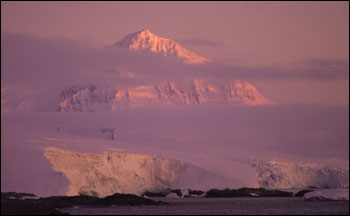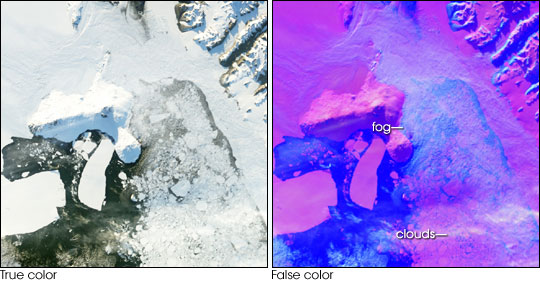

Clearing up Fog Formation |
|||
One of the problems he hopes MODIS can solve is predicting fog. Thick fog can materialize very rapidly, explains Cayette, and it poses a serious hazard to planes and boats. One airplane was coming in on approach for a landing, recalls Cayette, when the pilot suddenly lost the runway in a field of white. It took the pilot a few seconds to realize that fog had instantaneously obscured the ground for miles in every direction. |
|||

Such fog is difficult to predict, but MODIS may soon help forecasters see farther into the future. Typically, forecasters can predict fog by observing moisture in the atmosphere, but tracking increased water vapor on or near the surface requires a comprehensive network of sensors, such as the National Weather Service Stations and radar networks in the United States. In other parts of the world, the presence of clouds also indicates where the air is moist enough to produce fog. In Antarctica, however, clouds don’t form as readily in the cold, pristine air, and with fewer ground sensors, pockets of extremely moist air often aren’t detected until they settle to the cold ice surface and form visible fog. |
Fog and low clouds obscure the view of a mountain near Palmer Station on the Antarctic Peninsula. In Antarctica, fog can materialize suddenly, becoming a serious flight hazard. (Photo courtesy National Oceanic and Atmospheric Administration Photo Library) |
||
 |
|||
“No one has really studied fog in Antarctica,” says Lazzara, but he’s hoping that MODIS will help him understand why fog forms so quickly and how its formation can be predicted. MODIS provides a fuller picture of water vapor and fog formation than other satellite instruments because of its multispectral resolution, says Lazzara. When MODIS collects images of the Earth, it “sees” all of the components of visible light as well as thermal, shortwave, and near-infrared energy. In all, MODIS collects 36 different groups of wavelengths of energy, or spectral bands, and this wide range (or multispectral resolution) will let Lazzara distinguish fog from snow or other low clouds and observe atmospheric water vapor. |
Fog and clouds can be hard to distinguish in the true-color image (left). The false-color image (right) shows clouds in white and fog in blue. High-resolution versions are available for the true- and false-color images. (Image by Jesse Allen, Earth Observatory) |
||